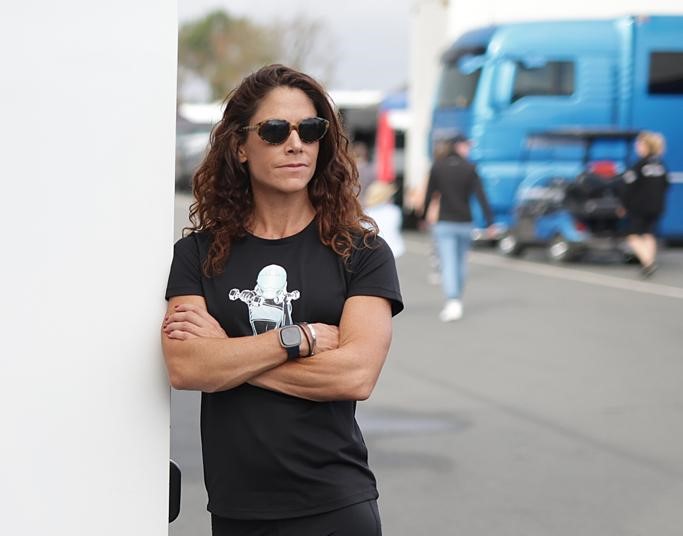From 0 – 100km/h in just three seconds, and with -1.5 G braking deceleration, the F1 Academy cars are a mighty piece of machinery to handle. That amount of speed and G force requires strength, endurance and reaction time that separates the drivers from those in the grandstands. Yet, training and nutrition are two elements that are often overlooked within motorsport.
Claire Johnson is a leading motorsport nutritionist and performance coach who works with the likes of Alpine, Formula Women and Formula E. She has an extensive background of over 20 years of experience in the fitness industry, helping drivers across a huge variety of motorsport categories to maximise their speed through training and nutrition.
“I’ve always had a love for F1 and racing. I grew up with a brother who was very into it. I kind of just always wanted to keep up with him.” Says Claire.
Training
Regardless of which discipline a driver races in, they will require a high level of fitness to withstand the physical demands of driving at high speeds for extended periods. Whilst they may not need the strength of a powerlifter, they do need strength, endurance, flexibility and coordination to handle the forces on their bodies during acceleration, braking and cornering.
All training programmes will incorporate both gym work and cardiovascular training. But, the focus of the programmes are tailored for each individual driver.
“There is no generic training programme for a driver, it’s vital to consider the category you’re racing in,” says Claire. “So a karter will need more focus on grip strength than a motorcycle rider. And single seater drivers face a more demanding physical challenge on their neck than those who compete in GT cars.”
“That’s why it is so important to focus on specific areas.”
Weight
One of the key elements all drivers must consider is their weight. Every extra pound of weight increases the overall mass that the engine, brakes, and tires must accelerate, decelerate and manoeuvre. This makes motorsport a sport of fine margins; a driver being slightly overweight can be hugely costly in lap time.
“I’ll use Max Verstappen as an example, because everyone knows him!” Says Claire. “His weight during the off season won’t be 3kg away from his weight during the season.
“You can’t be over 80kg in an F1 car with your race suit and helmet on. So your body weight needs to be somewhere between 75kg and 76kg. To keep at this level year round really requires a high level of discipline.”
You’re probably wondering how drivers without sufficient funding can afford specialists performance coaches to enhance their performance. But don’t panic, just like there are ways to keep costs down in other elements of motorsport, you can get in race shape without breaking the bank.
Last year, Claire launched the RaceFit app to give drivers access to specialised training, without having to pay for a coach. Featuring over 400 exercise videos, RaceFit has you covered whether you race in karting, single seaters, or on motorbikes. You can find out more about the app here.
“I’ve found through working with people that not everyone has the budget for one to one training. That’s why I created RaceFit, which gives you access to bespoke training regardless of your motorsport discipline.
“There’s programmes in there that can be tailored to you. Someone with a more limited budget can still optimise their training.”
Diet
Aside from fitness training, nutrition also plays a critical part in the performance of a racing driver. A balanced diet for a driver should include foods that are high in learn sources of protein (such as chicken breast and fish) as well as high in carbohydrates (such as wholegrain rice and pasta).
Particularly during a race weekend, it’s important for drivers to find the right time to refuel, without hindering their performance. The best way to do this? Eat little, and often.
“During a race weekend drivers can become nervous. This is why you should never overload with a big meal before heading out on track.
“We’re trying to avoid peaking too early and then crashing. We can do that by eating smaller amounts at regular intervals throughout the day.”
Recovery
During a race, a driver’s heart rate can average 170 beats per minute. That’s why Claire’s first focus after the chequered flag is to get her drivers into a state of relaxation in order to enhance recovery.
“Racing is physical, it can be a workout,” she says. “You’ll be hot, you’ll be sweaty. So straight away, you need to get hydrated and get some water in your system, and add in some electrolytes to replace fluids and salts you’ll have lost through sweating.
“It’s all about creating a calm environment for the driver. They shouldn’t be getting out of the car and having a coffee!”
Motorsport is a precise sport on the track, where every corner, every lap, must be mastered to unleash the full potential of the car. Yet, achieving such consistent speed isn’t just about skill behind the wheel, it’s a testament to relentless dedication to both training and nutrition.

